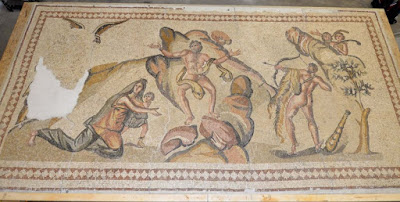No “Seize and Send” in Prosecution Involving Mosaic Reportedly from Syria
Grand jury indictment from federal court in California claims importer falsely classified ancient archaeological artifact.
 |
| Mosaic seized by FBI and HSI from Mohamad AlCharihi. |
Skilled prosecutors keep cases simple. So when U.S. Department of Justice (DoJ) attorneys secured an indictment last month in an antiquities trafficking case, they focused on one statute only, Entry of Goods Falsely Classified, 18 U.S.C. 541.
The straightforward charge, handed up by a grand jury sitting in the Central District of California, alleges that Mohamad Yassin AlCharihi (a/k/a/ Mohamad al-Sharihi), on August 13, 2015,
knowingly claimed and caused to be claimed, that he was importing a shipment of a mosaic and other items valued at $2,199, when, in fact, defendant AlCharihi knowingly imported a mosaic that itself was valued at more than $2,199, and defendant AlCharihi knowingly misrepresented the quality of the mosaic, including what the mosaic depicted.
The indictment in U.S. v. AlCharihi (20-cr-00307) simply is an allegation based on probable cause. The defendant is presumed innocent, and prosecutors bear the burden to prove the defendant’s guilt beyond a reasonable doubt.
The criminal investigation began approximately five years ago when the centuries old mosaic and other objects were imported into the U.S. A bill of lading, offered by AlCharihi in court papers, documented their ocean borne transport and their classification under Harmonized Tariff Schedule of the U.S. 6908.10 and 6802.91, codes that describe ceramic mosaic tiles and worked monumental or building stone. The bill of lading characterized the imports as “GARDEN ORNAMENTAL VASE” and “MOSAIC TABLE.”
FBI and Homeland Security Investigations executed a search warrant in March 2016 (16-0589M under seal) and confiscated the ancient mosaic along with documents and computers from AlCharihi’s home. The warrant authorized the seizure of “looted and/or stolen antiquities appearing to originate from Syria and/or Turkey, including mosaics and records related to antiquities.”
Prosecutors later initiated the civil forfeiture action of United States v. One Ancient Mosaic (18-cv-04420), alleging that the mosaic was a Roman Empire artifact from the Byzantine Period and “was consistent with the iconography of mosaics found in Syria.” They contended that email evidence revealed that the mosaic was from Syria.
Prior to the forfeiture case’s filing, AlCharihi himself sued the government in the case of AlCharihi v. United States of America, et al. (16-cv-07391). He insisted, “There was no intent or attempt to evade customs duties and introduce uninspected items into the United States. No false or forged documents were used to bring the items into the United States.” He averred that he invested money to enhance the value of the mosaic, arguing that it “was close to trash and in need of restoration.” The federal district court dismissed AlCharihi’s lawsuit in May 2017.
Facts and arguments offered in both civil cases are summarized in “Importer Restored Ancient Mosaic. FBI Seized It. Now U.S. Attorney Seeks Forfeiture” and likely will be re-presented in the pending criminal case
Assistant U.S. Attorney and Environmental Crimes Chief Joseph Johns played a role in the Markell cases. Now he exercises leadership over two attorneys assigned to the AlCharihi prosecution in his role as Chief, Environmental and Community Safety Crimes Section. Additional prosecutors appearing in the case display cooperation between Main Justice in Washington and attorneys in the Central District of California. The prosecutors include the Chief of the U.S. Attorney’s Criminal Division; the DoJ’s Acting Assistant Attorney General, Criminal Division; and Attorney Ann Marie Ursini from DoJ’s Human Rights and Special Prosecutions Section, the ten year old unit that pays attention to issues such as war crimes.
Because the government has claimed that the mosaic originates from conflict-ridden Syria, Ursini’s presence in the case is noteworthy. There has been an emerging recognition in the last several years of a relationship between transnational antiquities trafficking and U.S. national security, starkly illustrated by the case of U.S. v. One Gold Ring with Carved Gemstone, An Asset of ISIL Discovered on Electronic Media of Abu Sayyaf, President of ISIL Antiquities Department et al. (16-cv-02442) that was filed in federal court in the District of Columbia. The case innovatively applied one of America’s most robust anti-terrorism laws, the USA PATRIOT Act, to forfeit ISIS loot that U.S. soldiers identified during a 2015 raid in Syria.
If convicted, AlCharihi could face fines, imprisonment up to two years, or both. Meanwhile, the government seeks criminal forfeiture of the ancient mosaic.
Text and original photos copyrighted 2010-2020 by Cultural Heritage Lawyer Rick St. Hilaire, a blog commenting on matters of cultural property law, art law, art crime, cultural heritage policy, antiquities trafficking, looted, antiquities, stolen relics,smuggled antiquities, illicit antiquities, museum risk management, and archaeology. Any unauthorized reproduction or retransmission without the express written consent of CHL is strictly prohibited. The materials presented on this site are intended for informational purposes only and should not be used as legal advice applicable to the reader’s specific situation. In addition, the provision of this information to the reader in no way constitutes an attorney-client relationship. Blog url: https://culturalheritagelawyer.blogspot.com.

